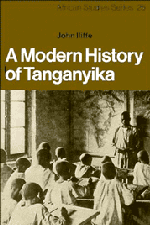Book contents
- Frontmatter
- Contents
- List of maps and tables
- Preface
- Acknowledgments
- Terminology
- Abbreviations
- Map I Tanganyika
- 1 Intentions
- 2 Tanganyika in 1800
- 3 The nineteenth century
- 4 The German conquest
- 5 Colonial economy and ecological crisis, 1890–1914
- 6 The Maji Maji rebellion, 1905–7
- 7 Religious and cultural change before 1914
- 8 Fortunes of war
- 9 The origins of rural capitalism
- 10 The creation of tribes
- 11 The crisis of colonial society, 1929–45
- 12 Townsmen and workers
- 13 The African Association, 1929–48
- 14 The new colonialism
- 15 The new politics, 1945–55
- 16 The nationalist victory, 1955–61
- Bibliography
- Index
- Frontmatter
- Contents
- List of maps and tables
- Preface
- Acknowledgments
- Terminology
- Abbreviations
- Map I Tanganyika
- 1 Intentions
- 2 Tanganyika in 1800
- 3 The nineteenth century
- 4 The German conquest
- 5 Colonial economy and ecological crisis, 1890–1914
- 6 The Maji Maji rebellion, 1905–7
- 7 Religious and cultural change before 1914
- 8 Fortunes of war
- 9 The origins of rural capitalism
- 10 The creation of tribes
- 11 The crisis of colonial society, 1929–45
- 12 Townsmen and workers
- 13 The African Association, 1929–48
- 14 The new colonialism
- 15 The new politics, 1945–55
- 16 The nationalist victory, 1955–61
- Bibliography
- Index
Summary
Nature and men
The eastern arm of the great rift valley cuts southward through Tanganyika and divides it into natural regions. To the west a plateau stretches away for 600 kilometres towards Lake Tanganyika. Woodland savannah 1,000 to 1,500 metres above sea level and seldom receiving more than 1,000 millimetres of rain in a year, this western plateau presents few obstacles to the movement and mingling of peoples. On its north-western rim it merges into the region of higher land, heavier rainfall, and more luxuriant vegetation which borders the western shore of Lake Victoria. At its southern edge the plateau gives way to the Southern Highlands, mountains and high plateaux running south-westwards to encircle the northern shore of Lake Nyasa. East of the rift, by contrast, the land slopes gently down towards the Indian Ocean. To the south of the River Rufiji this eastern region is predominantly rolling woodland savannah, but in the north high mountain outcrops – Kilimanjaro, Meru, Upare, Usa-mbara, Uluguru – thrust abruptly from the plain as islands of high rainfall and forest vegetation. These five regions – the western plateau, the north-west, the Southern Highlands, the south-east, and the north-east – are Tanganyika's natural divisions. Ecological diversity has been the first determinant of its history.
The men followed the dictates of the land. Africa's peoples speak languages belonging to four families, and variants of each were spoken in Tanganyika in 1800. The earliest recognisable inhabitants were hunters and gatherers who spoke Khoisan (‘click’) languages.
- Type
- Chapter
- Information
- A Modern History of Tanganyika , pp. 6 - 39Publisher: Cambridge University PressPrint publication year: 1979
- 1
- Cited by

